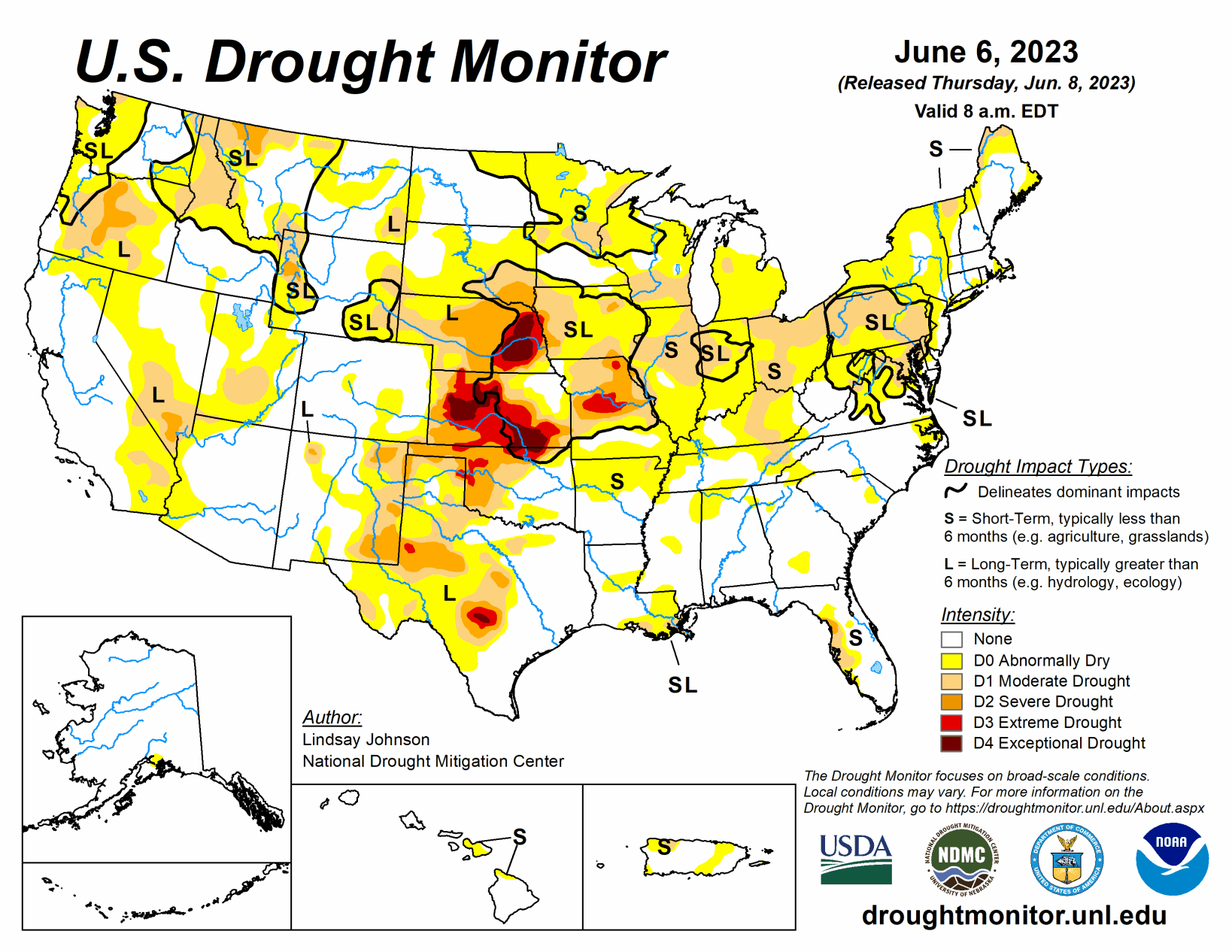Rain helping to ease drought

Heavy rains fell this week across some of the western parts of the central and southern Great Plains, especially in the Texas Panhandle and western Oklahoma and Kansas, leading to widespread improvements to ongoing drought in the western Great Plains.
In the West, some minor improvements occurred in parts of Nevada, Utah and Idaho, where high streamflows and large precipitation amounts from the winter into May led to a reassessment of conditions. Degradations were made in a few parts of western Montana and northwest Washington, where precipitation deficits mounted amid declining soil moisture and streamflow.
Relatively dry weather occurred this week in Arkansas, Tennessee, Mississippi and east-central and northeast Oklahoma. Farther west, in the Texas Panhandle, northwest Oklahoma and the eastern Oklahoma Panhandle, the recent wet pattern continued, and widespread 2- to 5-inch rains fell, with localized higher amounts. Widespread improvements were made to the drought and dryness depiction in this region, where soil moisture improved and precipitation deficits lessened.
The rest of Texas saw a mixture of a few improvements and degradations, as heavier precipitation amounts around the state were more spotty. Farther east in eastern Oklahoma and northern Arkansas, abnormal dryness and moderate drought were introduced or expanded in areas that have recently seen growing short-term precipitation deficits, declines in soil moisture, and lowering streamflows.
Unusually warm temperatures, reaching or exceeding 9 degrees above normal in large portions of Michigan, Wisconsin and Minnesota, also contributed to worsening dryness. Large-scale additions and expansions of abnormal dryness and moderate drought occurred, especially along and east of the Mississippi River and in central Minnesota, where the combination of precipitation deficits, low streamflow and declining soil moisture was most prevalent. Due to similar conditions along the Missouri River in western Iowa, some expansions were made to severe drought there.
Heavy rains fell over parts of the Colorado, Kansas, Nebraska and southeast Wyoming, leading to widespread one-category improvements in areas with increasing soil moisture and lessening precipitation deficits. After recent heavy rains, some improvements were also made in northeast and east-central Kansas. In eastern Nebraska, some heavier rains fell, but these were quite spotty, so drought areas remained mostly unchanged.Conditions improved in a small area southeast of Lincoln where rainfall amounts locally exceeded 4 inches. North of Omaha, extreme drought expanded slightly, as soil moisture and precipitation deficits worsened alongside poor streamflow. During May, Lincoln and Omaha both received much less than an inch of rainfall, and much of Saunders County received less than an inch of rain as well.
Omaha’s May total of 0.17 inches of rain came in as the driest May on record there. In South Dakota, moderate and severe drought increased in coverage in the southeast, where short-term precipitation deficits mounted amid decreased streamflow and soil moisture. Rolling corn was reported north of Mitchell, and very dry soils were reported in far southeast South Dakota, where impacts to agriculture and need for irrigation are quickly ramping up.
Moderate and severe drought increased in coverage in northwest Montana and northwest Washington, where short-term precipitation deficits were occurring amidst low streamflow and decreasing soil moisture. Due to heavy rains associated with a storm system responsible for the heavy rain in the southern Great Plains, some improvements were also made in east-central New Mexico.
Looking ahead
For June 8-13, an inch or more of rain is forecast from the Pacific Northwest to the western interior, then across the central Plains, northern parts of the Southeast, and much of the Midwest. Local amounts up to or exceeding 3 inches of rain is forecast in northern and central Montana and the northern Rockies of Colorado. A quarter inch or more can be expected in the northern Plains into the western Midwest, the Northeast and the South from Texas to Florida. Little to no precipitation is predicted for the lower four-corners area and Pacific West Coast.
For the period from June 13-17, the National Weather Service Climate Prediction Center forecast favors below-normal precipitation across parts of the south-central and southeast United States, especially the central and western Gulf Coast areas into southwest Texas and southern New Mexico. Above-normal precipitation is favored in the Intermountain West and Great Basin, and with lesser confidence also favored from the central Great Plains eastward into the Ohio Valley, Mid-Atlantic, and Northeast. Below-normal precipitation is favored in the Great Lakes vicinity.
In the Lower 48, cooler-than-normal temperatures are favored in the Southwest and Intermountain West, excluding southeast New Mexico, and in the Upper Ohio River Valley. Warmer-than-normal temperatures are more likely in the north-central and northwest United States, especially in Minnesota and surrounding states, and from Texas and Oklahoma southeast into southern Alabama and Georgia and all of Florida.
Sign up for HPJ Insights
Our weekly newsletter delivers the latest news straight to your inbox including breaking news, our exclusive columns and much more.



